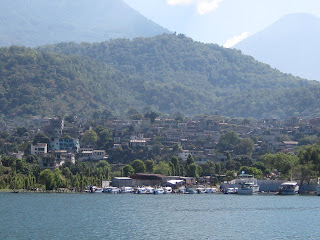I befriended a delightful family from Calgary, Canada who are also staying at Los Encuentros until the end of the month. Kurt works as an accountant and Zoë home-schools their two sons: Nolan (8) and Zac (6). The family decided to take six months off and travel to Central America to learn Spanish and different Latin-American cultures while still home-schooling their children. They spent a month in El Salvador, two months in Nicaragua, and are now in Guatemala, and in February they will move on to Roatan, Honduras. Zoë and Kurt love Guatemala and are seriously considering returning there in September 2009 with their sons to spend a year. They are currently checking out rental places before they depart for Honduras.
Zoë and Kurt graciously invited me to tag along with them on an excursion to San Juan La Laguna, another charming village on Lake Atitlán. It has a population of 8,000 inhabitants who are exclusively indigenous. Richard Morgan, our B & B host, knows well-known Mayan artists who are based there. One artist is Felipe Ujpan whose works have been exhibited in the U.S. He belongs to a group of indigenous artists who have been characterized “Primitivist” oil painters. On our behalf, Richard called Felipe and told him we were coming to San Juan and asked if he could meet us at the drop-off area and take us to his studio. Felipe was most happy to comply.
We took a boat to San Pedro and from there took a picop to San Juan for 3 Quetzales (less than 50 cents).
On our way from San Pedro to San Juan
I called Felipe on my cell phone and he came to greet us and accompany us to his studio that is near town center. We were enamored with Felipe’s exquisite work which focused primarily on Mayan traditions. Felipe also showed us a few paintings from a protégé of his, Diego Luis. I bought one of Felipe’s paintings for a modest 130 dollars (he told me he had spent an entire month on it) and the Canadian couple bought an impressive painting from his protégé for 70 dollars. We all left the studio elated and excited. We felt we were now “collectors” of artwork that we would never be able to afford in our countries.
Felipe Ujpan in the doorway to his studio in San Juan
Felipe holding the painting I bought
I fell in love with the village of San Juan La Laguna. Its streets are clean and obviously well-maintained by its proud citizens. There is very little traffic. Aside from an advertised beach called Las Cristalinas, San Juan is mostly ignored in tourism books. There are many impressive grassroots cooperatives. One of them is COOP LEMA, a weaver’s cooperative whose members consist of only women from the village. They dye their wool with local natural plant materials and sell them directly to visitors. One can visit the weavers as they demonstrate their century-old craft.
Women from the COOP LEMA demonstrating their art
The children in Guatemala are so charming and endearing. They come up to you and ask you if you want to take a picture of them. As we strolled through the narrow streets of San Juan, these children called out to us.
Best friends
More beautiful children of San Juan
San Juan La Laguna teems of art: Here is one of the many street murals painted by a local artist. These murals can viewed at every street corner.

















































